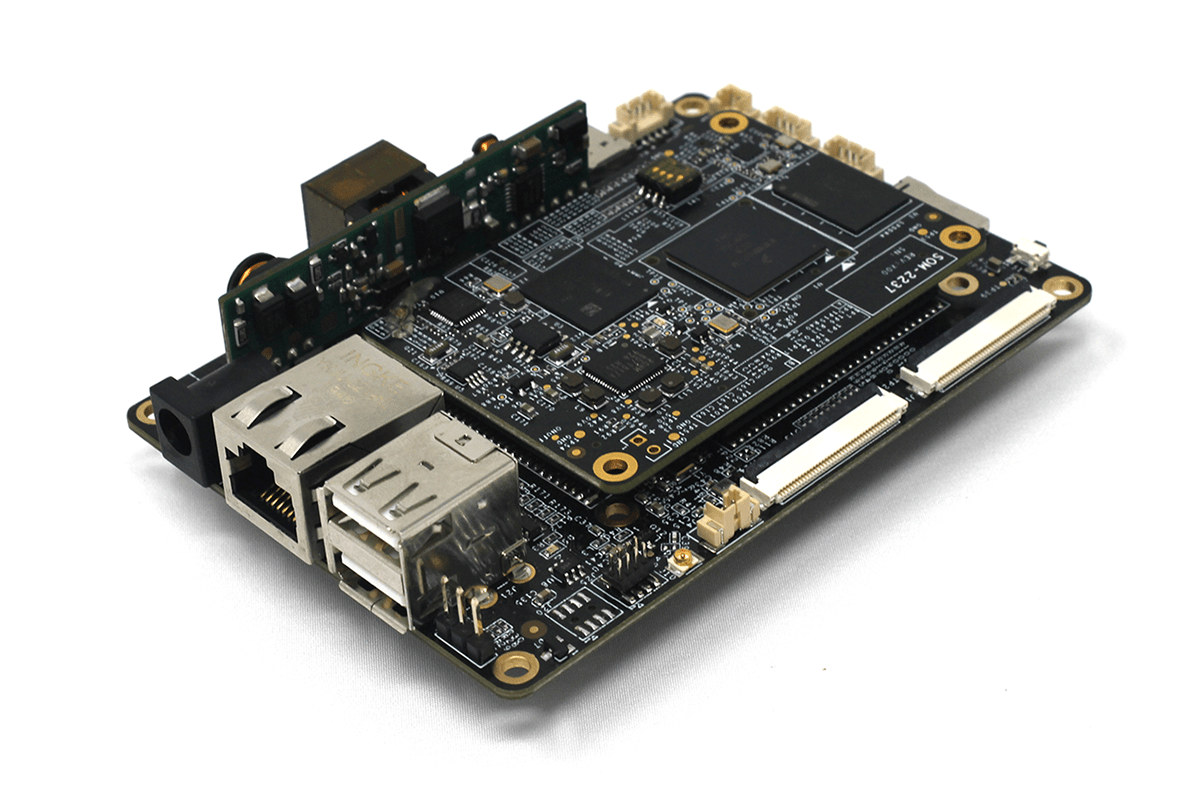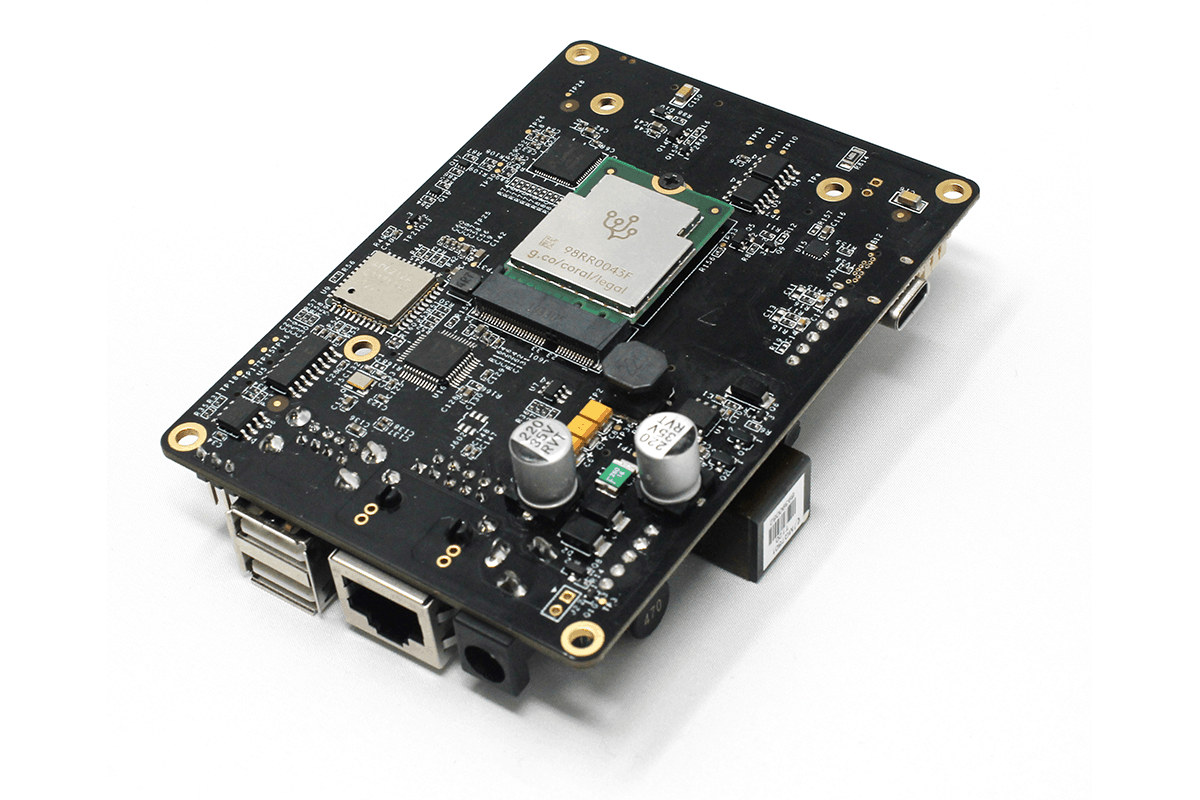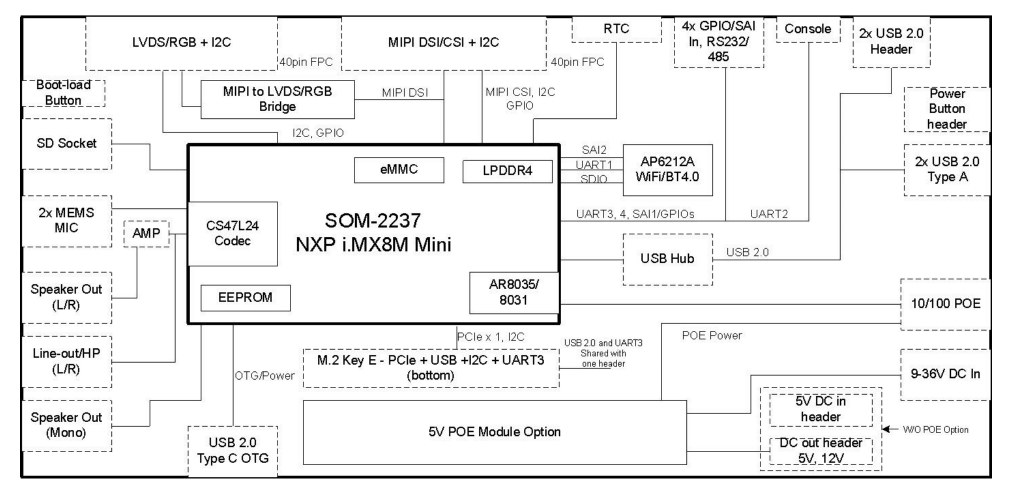We’ve covered several NXP i.MX 8M Mini SBC‘s since the announcement of the processor in 2018 as the first i.MX SoC manufactured with a 14nm process allowing for a higher CPU clock of 2.0 GHz compared to the 1.5 GHz frequency used with the original i.MX 8M processor. i.MX 8M Mini also removes some features (4K video playback, some video interfaces, …) in order to lower the cost of the processor.
Companies are still releasing new i.MX 8M SBCs regularly, but we don’t always cover them all since many often do not offer much compared to the competition. But Estone Technology EMB-2237-AI Pico-ITX SBC has some unusual features and options including a Cirrus Logic audio DSP, as well as support for a PoE module and Google Coral M.2 AI accelerator module.

EMB-2237-AI SBC is comprised of a system-on-module and baseboard with the following specifications:
- Estone SOM-2237 module
- SoC – NXP i.MX8M Mini Dual or Quad Cortex-A53 @ up to 1.8GHz with Cortex-M4F @ 400MHz, Vivante GCNanoUltra 3D GPU, Vivante GC320 2D graphics accelerator
- System Memory – 2GB or 4GB LPDDR4 RAM
- Storage – 8GB (default) iNAND flash, 265K EEPROM with write protect control
- Audio – Cirrus Logic CS47L24 dual-core audio signal processor (300 MIPS) for multi-mic noise suppression, acoustic echo cancellation (AEC), omnidirectional spatial audio
- Networking – Atheros AR8035/AR8031 Gigabit Ethernet PHY (based on info from the block diagram below)
- Dimensions – TBD
- IOB-2407 baseboard
- Storage – MicroSD slot
- Display I/F
- 1x 4-lane MIPI DSI, 1x dual-channel LVDS and 24-bit RGB for 5”, 7”, 8”, 10.1” and other size LCD panels up to 1920×1200 resolution
- I2C touch interface
- Camera I/F – 4-lane MIPI-CSI + I2C header
- Audio
- 1x mono Class D speaker out, 2W(4Ω),
- 2x (R/L) line-out and amplified (2x 1.5W) out headers
- Voice Control – Dual digital MEMS microphone header
- Connectivity
- 10/100M Ethernet port (RJ45) with IEEE 802.3af compliant PoE
- 802.11 b/g/n and Bluetooth 4.0 via Ampak AP6212 module
- USB – 2x USB 2.0 Type-A, 2x USB 2.0 header, 1x USB Type C OTG
- Serial – RS-232/RS-485 header
- Expansion
- 4x GPIO, 2x I2C (for TP and MIPI CSI)
- 1x M.2-2230 (E key) slot for optional Google Coral M.2 A+E Key module (4 TOPS)
- Debugging Serial debug console header
- Misc – RTC with battery; watchdog; boot button with multiple boot options
- Power
- 12V via DC power barrel
- Optional 9-36V support (info from the block diagram)
- 5V via optional PoE module
- Temperature Range – 0 to 60°C; 5 to 95% @ 40°C non-condensing humidity tolerance
- Dimensions – 100 x 72mm (Embedded Pico-ITX form factor)

The company provides a Yocto based Linux with kernel 4.14 Qt+Wayland as well as an Android 9 BSP. When connected to a microphone array, the board can be used with Amazon AVS (Alexa Voice Service) Device SDK and Sensory TrulyHandsfree Wake Word Engine. You’ll find resources to get started with the board in the Wiki.
The SoC can handle AI acceleration using OpenCL, but this method delivers on 32 GOPS, so adding an M.2 card with the 4 TOPS Google Edge TPU coprocessor will help with artificial intelligence workloads.

There’s an oddity in the design, as Qualcomm AR8035/8031 chips are Gigabit Ethernet transceivers, but the baseboard only supports Fast Ethernet. I haven’t been able to find the rationale for this choice, but I have the feeling it may be related to PoE support.
The company did not provide availability nor pricing information. More details, including a datasheet and user manual, can be found on the product page.
Via LinuxGizmos

Jean-Luc started CNX Software in 2010 as a part-time endeavor, before quitting his job as a software engineering manager, and starting to write daily news, and reviews full time later in 2011.
Support CNX Software! Donate via cryptocurrencies, become a Patron on Patreon, or purchase goods on Amazon or Aliexpress




